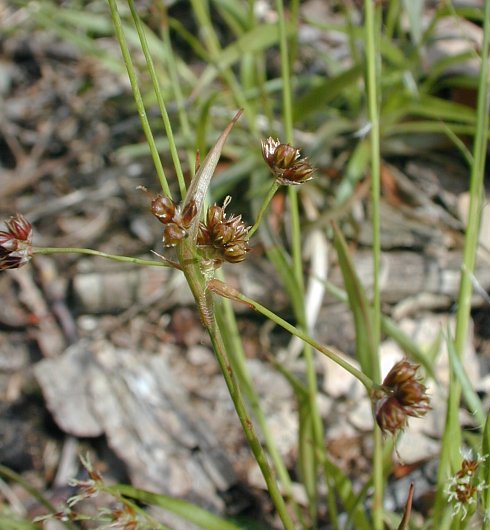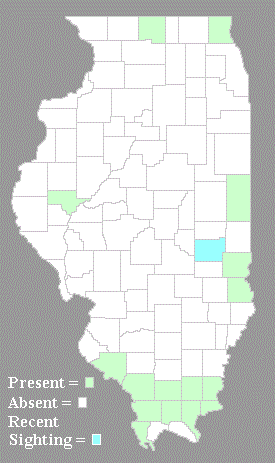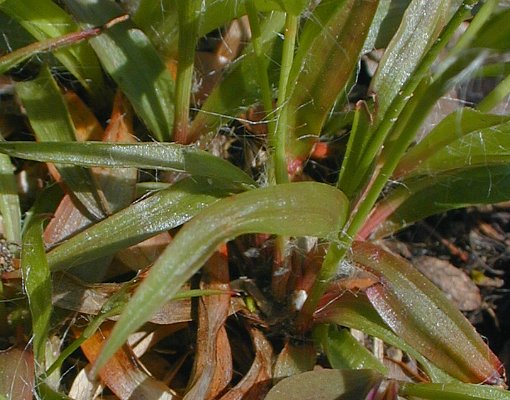
Each culm terminates in an umbel of 3-12 flower clusters. The rays (floral stalks) of this umbel are nearly zero to 3" long; they are straight, light green, and terete. The rays are divergent by greater than 60º; they are erect, ascending, widely spreading, or declining. Individual flower clusters are 5-7 mm. long and 7-11 mm. across; they are usually subgloboid in shape (more broad than tall), consisting of a dense cluster of 3-8 flowers. Each flower consists of 6 scaly tepals, 6 stamens, and a pistil. The tepals are 2.5-3.5 mm. in length and lanceolate in shape; they are light brown to dark brown, except for their margins, which are white-membranous. At the base of each flower or flower cluster, there are one or more chaffy bractlets that are less than 12 mm. in length (usually less than 3 mm.). At the base of each inflorescence, there is a leafy bract up to 2" long, resembling a small leaf blade. The blooming period occurs during mid- to late spring, lasting about 1-2 weeks. The flowers are cross-pollinated by the wind. Afterwards, the ovaries develop into seed capsules that are a little shorter or a little longer than the tepals. These capsules are obovoid-globoid and somewhat 3-lobed longitudinally,
 terminating
abruptly into a very short beak. At maturity, each capsule splits open
into 3 sections from the top, releasing 3 seeds. These seeds are small
and light enough to be blown about by the wind. Individual seeds are
about 1.5 mm. in length (excluding their food appendages), broadly
ellipsoid in shape, and dark brown. Attached to one end of each seed,
there is a white food appendage about 0.5 mm. in length. The root
system is fibrous and rhizomatous, occasionally forming clonal offsets.
terminating
abruptly into a very short beak. At maturity, each capsule splits open
into 3 sections from the top, releasing 3 seeds. These seeds are small
and light enough to be blown about by the wind. Individual seeds are
about 1.5 mm. in length (excluding their food appendages), broadly
ellipsoid in shape, and dark brown. Attached to one end of each seed,
there is a white food appendage about 0.5 mm. in length. The root
system is fibrous and rhizomatous, occasionally forming clonal offsets.Cultivation: The preference is partial sun, dry-mesic conditions, and soil containing some clay, rocky material, or sand. Most growth and development occurs during the cool weather of spring.
Range & Habitat: The native Hedgehog Wood Rush (Luzula echinata) is fairly common in southern Illinois, while in the rest of the state it is uncommon or absent. Habitats include upland areas of hilly woodlands, areas along paths in upland woodlands, thinly wooded bluffs, shaded rocky cliffs and rocky ledges, and sand prairies. This rush is found in natural areas of moderate to high quality. Some disturbance is probably beneficial if it removes excessive shade from overhead canopy trees.
Faunal Associations: Very little is known about floral-faunal relationships for this species. Because the seeds have food appendages, they are carried about by ants and possibly other insects. These insects help to spread the seeds to new locations.
Photographic Location: Along the path of a hilly woodland near Lake Charleston in east-central Illinois.
Comments: In spite of its grassy or sedge-like appearance, the native Hedgehog Wood Rush (Luzula echinata) is a member of the Rush family (Juncaceae) as its seeds and scaly tepals are typical of species in this family. Several Luzula spp. (Wood Rushes) are very similar to each other and rather variable, resulting in some taxonomic instability. For example, Hedgehog Wood Rush has been classified as a variety of the European Luzula campestris (Field Wood Rush), or Luzula campestris echinata. It has also been classified as a subspecies or variety of the native Luzula multiflora (Common Wood Rush), or Luzula multiflora echinata. At the present time, most taxonomists consider Hedgehog Wood Rush to be a distinct species, as treated here.

Because the range of Hedgehog Wood Rush overlaps with the range of Common Wood Rush in Illinois, it is easy to confuse these two similar species. Compared to Common Wood Rush, the floral umbels of Hedgehog Wood Rush have more divergent rays (exceeding 60º), some of which are often widely spreading or declining. Hedgehog Wood Rush also tends to have fewer flowers in its flower clusters (3-8) and these clusters are more flattened (they are wider than they are tall). Another native species in Illinois, Luzula bulbosa (Bulbous Wood Rush), is similar in appearance to the preceding species. However, this last species can be distinguished by the small bulbous tubers of its root system and slightly smaller seeds (typically about 1.0 mm. in length, excluding the food appendages). All of these native species seem to prefer upland woodlands and similar habitats. They typically develop and bloom before the vernal leaves of canopy trees have opened fully.